There are several species of watersnakes native to North America. Several watersnakes can be found in Virginia, including the following ones.

You can find these snakes across the state in streams, rivers, ponds, lakes, streams, and marshes. The northern watersnake is the most widely distributed and often identified as the cottonmouth, a venomous snake. The cottonmouth is semi-aquatic and also found in the state. It’s one of the more dangerous snakes. Not all these snakes are strictly aquatic. Most also spend time on land. Some of them are venomous, as well. We’ll take a look at each of these watersnakes below and discuss how dangerous they are.
1. Northern Cottonmouth
The northern cottonmouth is venomous and one of the more dangerous watersnakes in Virginia. It’s primarily found in southeastern Virginia, especially around Virginia Beach and Chesapeake.
Like many venomous snakes, Cottonmouths are heavy and have flattened heads. Their head is a spade-shaped, which makes them easy to tell apart from other snakes. Their a dark green to black color with several dark brown to black hourglass bands. When threatened, the snake will display its white mouth, hence its name.
This species primarily consume aquatic prey, such as fish and turtles. However, it will also prey on mammals and other snakes. They float on the water’s surface, unlike most watersnakes swimming below it.
These snakes prefer creeks, swamps, marshes, lakes, and ponds.
Despite being venomous, cottonmouth snakes aren’t aggressive and prefer to flee when possible. They only bike when provoked or cornered.
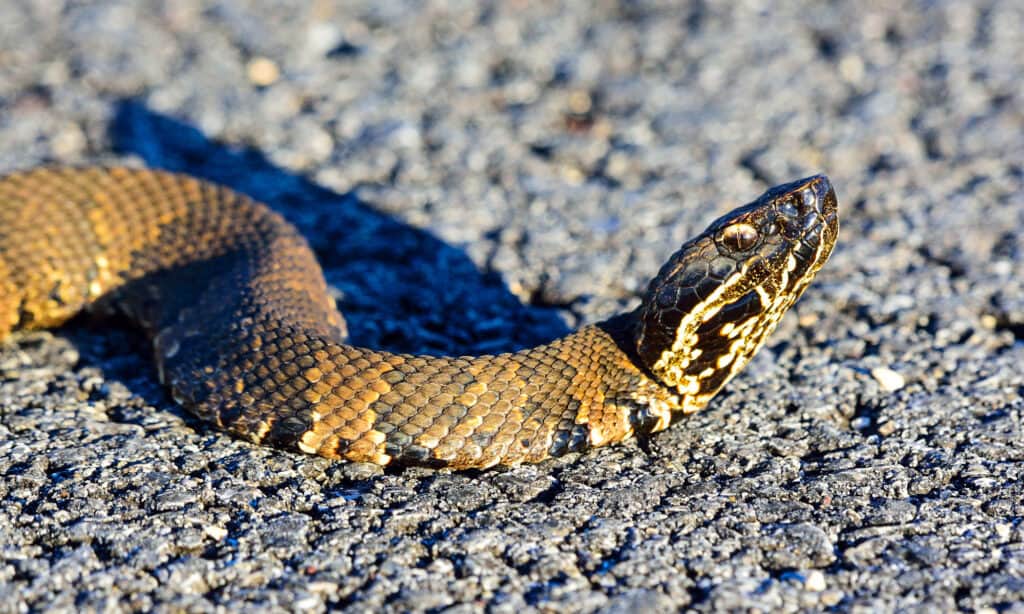
The northern cottonmouth is venomous and one of the more dangerous watersnakes in Virginia.
©Ad Konings/Shutterstock.com
2. Eastern Copperhead
The eastern copperhead is another venomous snake species in Virginia. These pit vipers have a reddish-brown coloration with several hourglass-shaped bands. Like many venomous snakes, they have triangular heads. They also have heat-sensing pits between their eyes and nostrils.
These snakes mostly eat rodents but may also prey on birds, frogs, lizards, and other snakes. They prefer deciduous forests, woodlands, rock outcroppings, and low-lying swamp regions. They aren’t true watersnakes, but you can find them near river habitats.
Copperheads hide in areas with plenty of leaf and plant debris. They prefer to stay hidden for much of the day and are most active around dusk. They aren’t aggressive and attempt to camouflage or flee when threatened. However, they will bite when stepped on.
Their venom is hemotoxic, which means it destroys blood cells and tissues. Symptoms after being bitten include extreme pain, tingling, nausea, swelling, and tissue damage.

The eastern copperhead is another venomous snake species in Virginia.
©iStock.com/JWJarrett
3. Eastern Racer
The eastern racer is a nonvenomous snake from the family Colubridae. They have slender bodies and rounded heads that aren’t distinguishable from their neck. They have a solid-colored body, but the exact color depends on the subspecies. Their underbelly is lighter-colored and can be white, tan, or yellow.
This snake mostly eats rodents, birds, eggs, frogs, and lizards. They’re particularly found in grasslands, but you may also see them in marshes and new water sources. They prefer open spaces with plenty of sunlight.
Eastern racers are extremely active, which is how they got their name. They’re often found raising their head about the gas to look around. They prefer to roam around during the day but may be active at night if the weather is particularly hot.
These snakes are almost completely harmless. They won’t attack unless cornered or handled and aren’t venomous.

The eastern racer is a nonvenomous snake from the family
Colubridae.
©HWall/Shutterstock.com
4. Mud Snake
The mud snake is found in the southeastern United States, including Virginia. They’re nonvenomous with heavy bodies and short tails. They’re rather cylindrical in shape. Their back is a glossy black, and their underside is red.
These snakes mostly eat giant aquatic salamanders, as well as other amphibians. They tend to inhabit the edges of streams and cypress swamps, usually in areas with dense vegetation. They like to burrow into the mud and need soft ground to do this.
These snakes are mostly aquatic and nocturnal. They’ll try to hide when disturbed during the day. However, they will bite if handled. They’re known for using their pointed tail to prod prey items, which led to the nickname “stinging snake.” Despite this, they can’t actually sting.
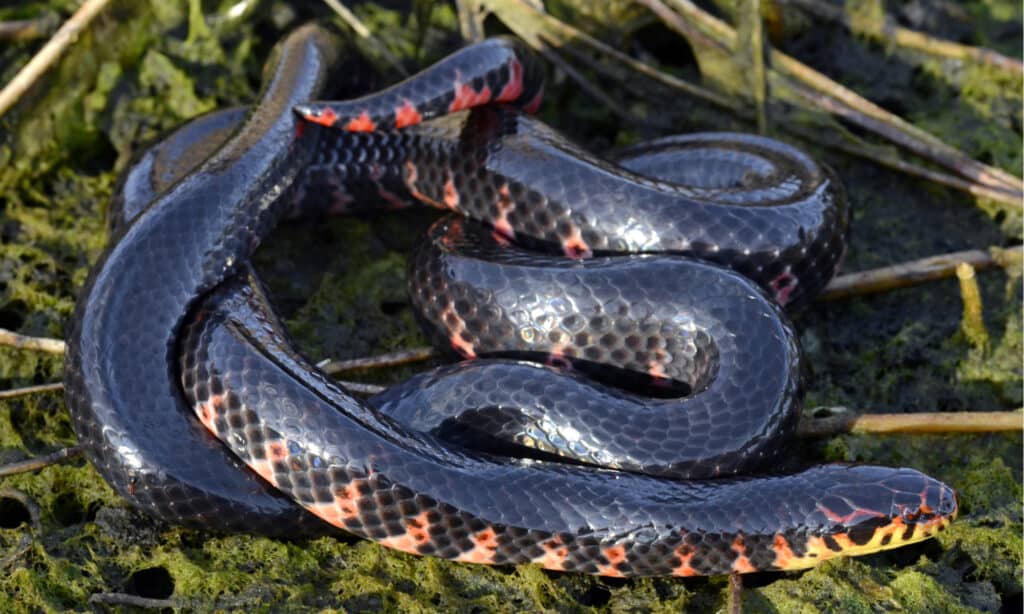
The mud snake is found in the southeastern United States, including Virginia.
©Patrick K. Campbell/Shutterstock.com
5. Glossy Crayfish Snake
As their name suggests, the glossy crayfish snake consumes mostly crayfish. However, they will also eat other aquatic invertebrates and amphibians.
They’re found throughout the southeastern United States, including Virginia. They’re nonvenomous with a heavy body and short head. They have unusually large eyes.
These snakes are extremely glossy with a brownish-to-olive color. Sometimes, they have two light stripes running down their body. On their underside, they are yellow with black spots.
They prefer to live in slow-moving, muddy streams. They like to hide, so they prefer areas with lots of vegetation and debris to provide cover. They’re mostly aquatic, spending most of their time in the water.
These snakes are nonvenomous and will attempt to hide or escape if bothered. If you pick one up, it may bite you, though.
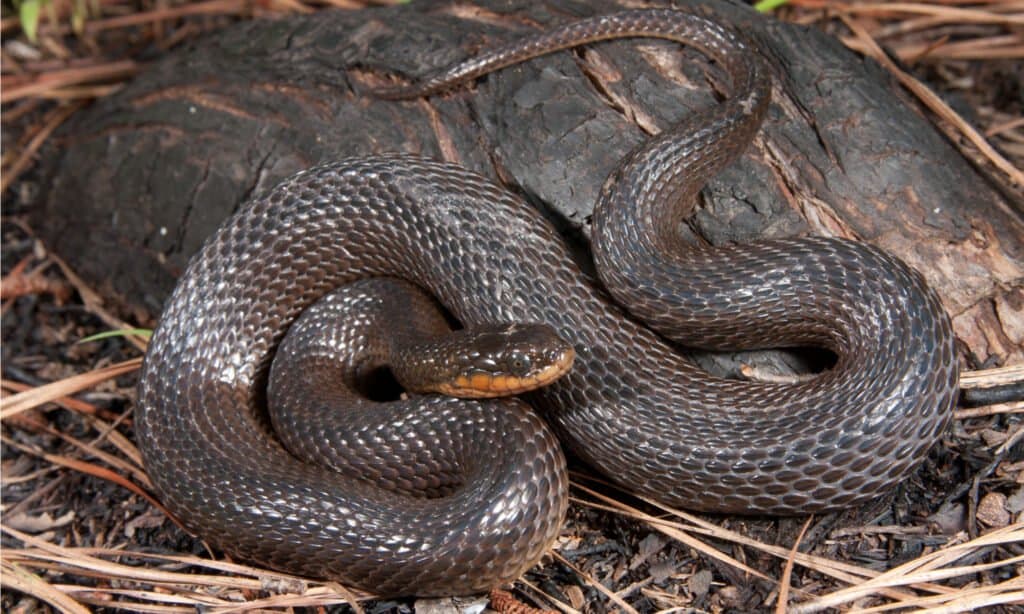
As their name suggests, the glossy crayfish snake consumes mostly crayfish.
©Nathan A Shepard/Shutterstock.com
6. Queen Snake
Queen snakes are another nonvenomous snake found in Virginia. They have a slender body and rounded head that isn’t distinct from the rest of their body. They’re olive to dark brown with yellow stripes running down their bodies. Their belly is cream to yellow with four dark stripes.
They consume mostly crayfish, but they will eat other aquatic invertebrates and amphibians. They prefer lots of sunlight, so they’re drawn to open areas. They’re most active during the day but may also be active at night occasionally.
When disturbed, the snake will drop into the water, where it can swim quite well. They aren’t aggressive in the least. They’re often mistaken for the garter snake, but they do not have any pit organs.
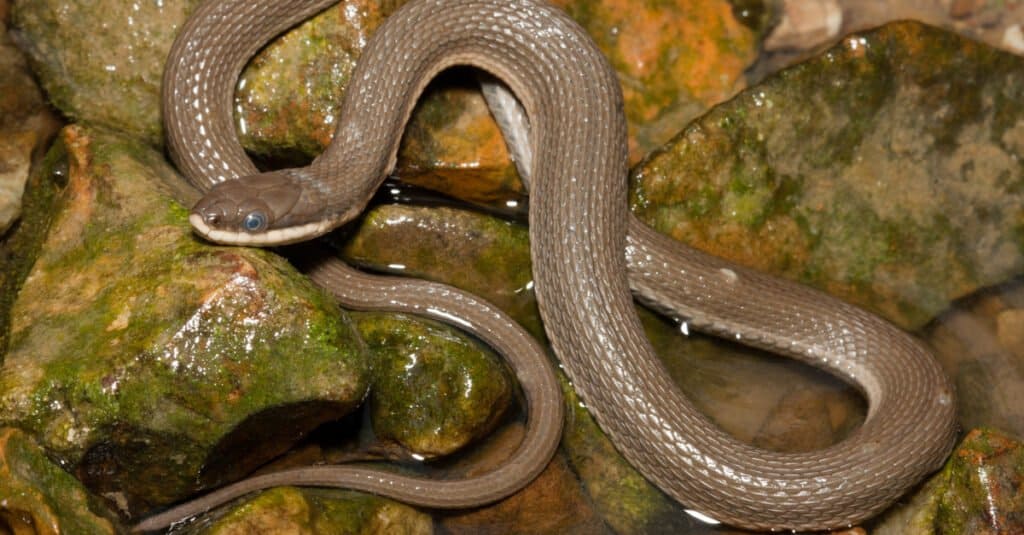
Queen snakes are another nonvenomous snake found in Virginia.
©Nathan A Shepard/Shutterstock.com
7. Rainbow Snake
The Rainbow Snake belongs to the family Colubridae and is nonvenomous. It has a long, slender body with a pointy head. They’re darkly colored with red stripes down their bodies. These stripes are surprisingly brightly colored, where the snake gets its name.
They consume mostly amphibians, such as eels and sirens. They’re found throughout the coastal plain of the southern United States, which includes parts of Virginia.
They prefer to live in cypress swamps and flower water habitats, such as creeks, streams, and rivers. Rainbow snakes like habitats with plenty of mud and vegetation, which helps them hide. They aren’t aggressive and will hide when possible.
These snakes spend much of their life in the water and are nocturnal.
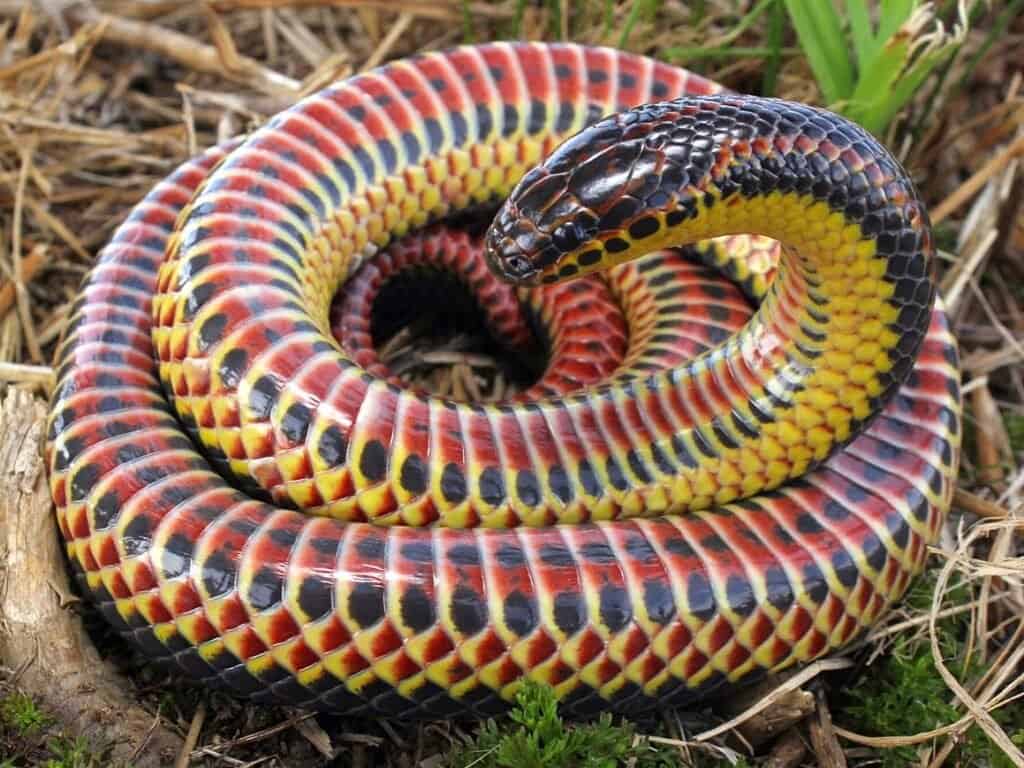
The Rainbow nake belongs to the family
Colubridaeand is nonvenomous.
©Charles Baker / CC BY-SA 4.0 – License
8. Brown Watersnake
The nonvenomous brown watersnake belongs to the family Colubridae. They have heavy bodies that are cylindrical-shaped. Their neck is very narrow, and their head is broad and distinctive. They’re usually brown or rusty brown, with around 25 dark splotches down their back. Their underside is yellow but often with heavy black or brown markings.
They mostly consume fish, frogs, salamanders, and crayfish. They’re opportunistic to some extent, so they consume whatever comes along.
They’re mostly found in southeastern Virginia in the lower coastal regions. They prefer to live anywhere with water, including swamps, canals, rivers, lakes, ponds, and streams. They do need lots of vegetation and debris to hide, though.
They’re extremely good at climbing and swimming. They’ll often climb branches overhanging the water for basking. When disturbed, they escape into the water, where they can swim to safety.
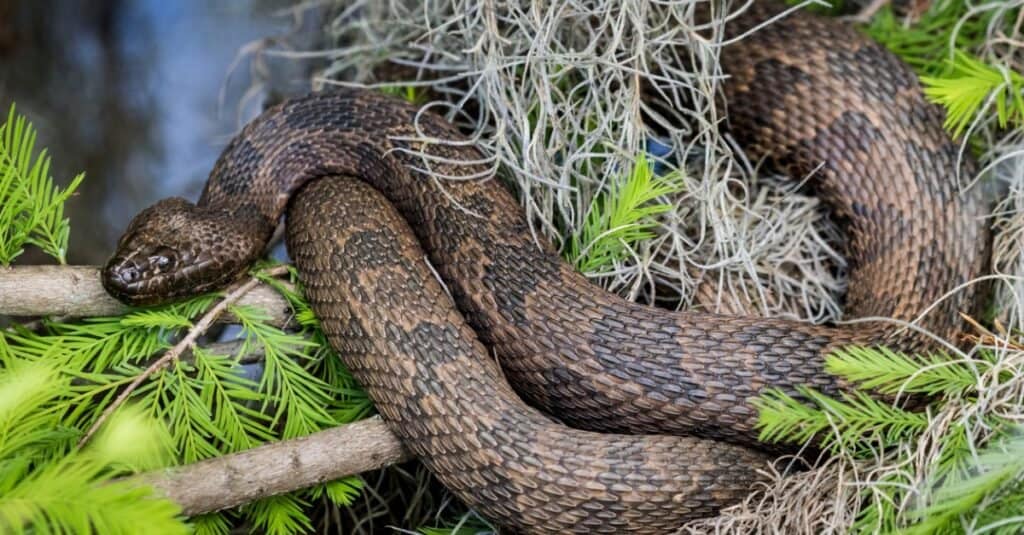
The nonvenomous brown watersnake belongs to the family
Colubridae.©iStock.com/csraphotography
9. Plain-Bellied Watersnake
The plain-bellied watersnake is nonvenomous and native to every southeastern state in the U.S., including Virginia. However, they’re mostly only found in southeastern Virginia on the east coast.
They have heavy bodies with very narrow necks. Their coloration is rather plain-looking, hence their name. They can be olive, gray, brown, or black. Their underside is pale yellow or orange without very few markings, if any.
This snake consumes fish for the most part. They may also eat frogs, salamanders, and crayfish. They prefer rivers, floodplains, lakes, ponds, and wetlands. Like many snakes, they hide in vegetation and prefer areas with plenty of plants.
They’re active during the day except during the hottest part of the year, when they may switch to nocturnal activity.
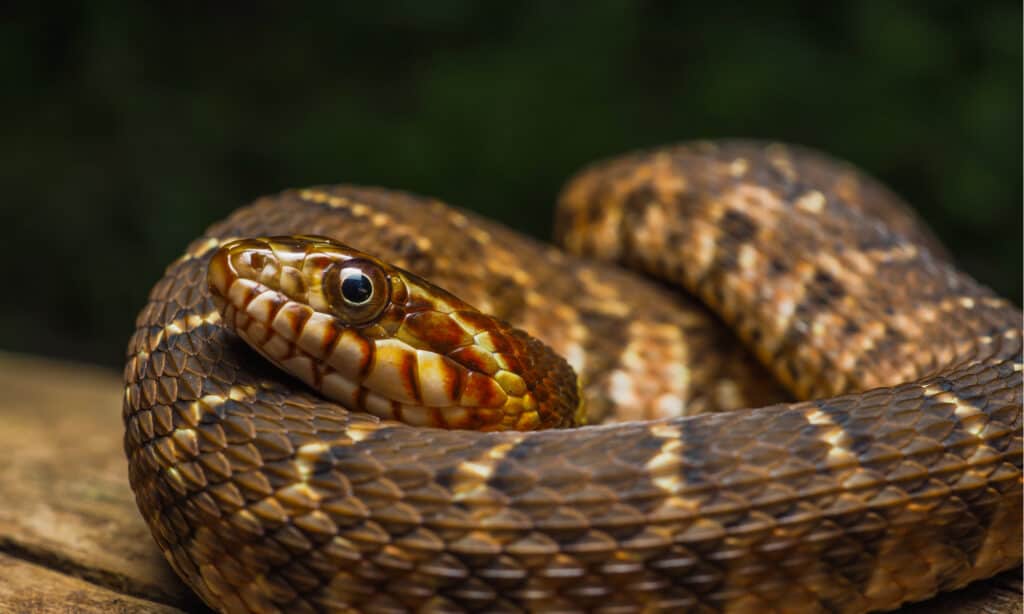
The plain-bellied watersnake is nonvenomous and native to every southeastern state in the U.S., including Virginia.
©Tyler Albertson/Shutterstock.com
10. Northern Watersnake
Finally, we have the northern watersnake, one of Virginia’s most common watersnakes. They can be found nearly everywhere in Virginia, as they’re native to much of central and eastern North America.
These snakes have large bodies with rounded heads. They don’t have distinctive necks.
They’re either brown, tan, or gray. Usually, they have square-ish blotches that form crossbands across their body. Their belly is cream to yellow with irregular rows of “half-moons” in a darker color.
They eat aquatic animals like fish, frogs, salamanders, and crayfish. They prefer to inhabit anywhere with a decent amount of water, including rivers, streams, ponds, lakes, canals, and marshes. However, they also need lots of sunlight for basking.
These snakes are diurnal, meaning they’re most active during the day. However, they don’t like the hot weather, so they may switch to nocturnal activity when it heats up in the summer.
They’re very good swimmers. Therefore, they attempt to drop into the water and escape that way when threatened.
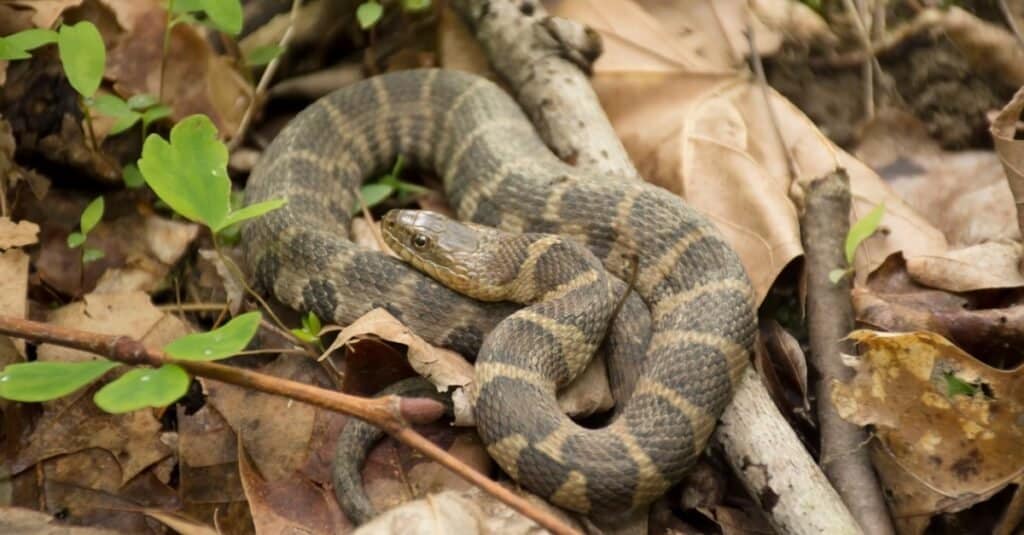
The northern watersnake, is one of Virginia’s most common watersnakes.
©iStock.com/IcemanJ
Where Are Watersnakes Found in Virginia?
Watersnakes can be found in some form throughout much of Virginia. There isn’t a particular place where watersnakes are particularly common, though not all species are distributed evenly throughout the state.
The northern watersnake is more widely distributed and can be found nearly everywhere. Other species may only inhabit certain portions of the state. Watersnakes can be found in every county and municipality in Virginia to some degree.
Watersnakes prefer to hang out in areas with water and food. This includes lakes, streams, rivers, ditches, and backyard pools. Some species are pickier than others about where they reside. Some are sensitive to water pollution and won’t be found around larger cities, for instance.
Most watersnakes feed on aquatic animals, including fish, frogs, salamanders, and crayfish. Watersnakes will follow their food source. Where there are lots of opportunities to grab a bite, you’ll likely find many snakes. Sterile backyard ponds and pools often don’t attract snakes for this reason (though the occasionally confused snake may still wander into them).
Because they’re reptiles, they don’t produce their own body heat. Therefore, they’ll spend some amount of time basking in the water. Many water snakes will bask above or very close to the water, as they often use swimming to escape danger. Just because they’re water snakes doesn’t mean they spend every second of their life in water.
Remember, some of the snakes we listed above around “true” aquatic snakes and may only occasionally wander into wetlands. Just because you aren’t by the water doesn’t mean you won’t find cottonmouths. Don’t solely ID a species based on location, as snakes can often wander outside their preferred habitat.
Summary of 10 Watersnakes in Virginia
Here is a summary of the watersnakes in Virginia with information on the danger level of the snake. In cases of low danger – the snake will only bite if threatened and is not venomous.
| # | Watersnake | Danger Level |
|---|---|---|
| 1 | Northern Cottonmouth | Venomous |
| 2 | Eastern Copperhead | Venomous |
| 3 | Eastern Racer | Low |
| 4 | Mud Snake | Low |
| 5 | Glossy Crayfish Snake | Low |
| 6 | Queen Snake | Low |
| 7 | Rainbow Snake | Low |
| 8 | Brown Watersnake | Low |
| 9 | Plain-Bellied Watersnake | Low |
| 10 | Northern Watersnake | Low |
The photo featured at the top of this post is © Thesigner_2696/Shutterstock.com
Discover the "Monster" Snake 5X Bigger than an Anaconda
Every day A-Z Animals sends out some of the most incredible facts in the world from our free newsletter. Want to discover the 10 most beautiful snakes in the world, a "snake island" where you're never more than 3 feet from danger, or a "monster" snake 5X larger than an anaconda? Then sign up right now and you'll start receiving our daily newsletter absolutely free.
Thank you for reading! Have some feedback for us? Contact the AZ Animals editorial team.






